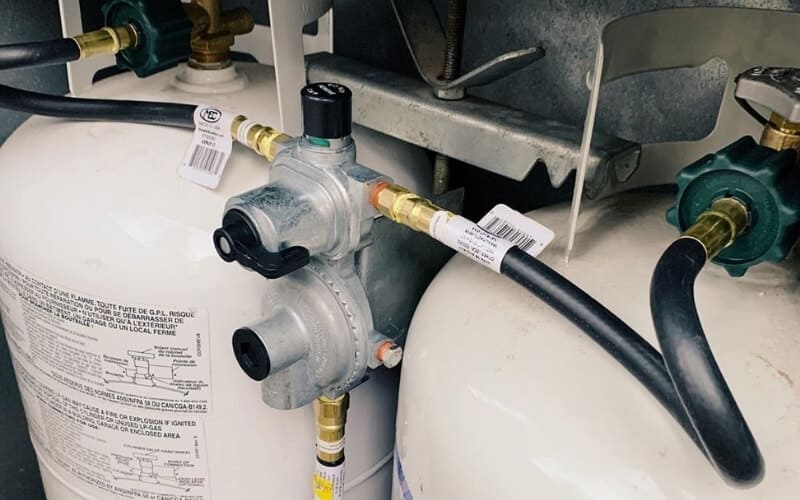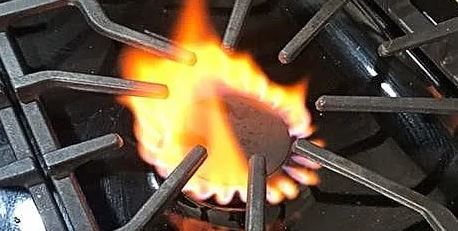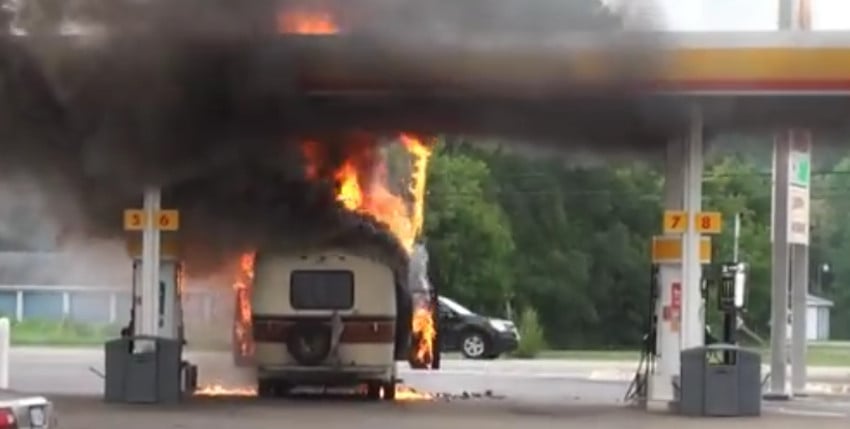
Propane Safety
Back in April of 2020, an explosion went off in a recreational storage yard that was so loud it was heard from blocks away. It was later determined by emergency officials that it was a propane explosion that tore apart an RV, severely damaged other units surrounding it and left one man deceased.
While the exact location of the initial ignition was not released, any RV or trailer owner is probably familiar with the propane lines of their rig. Whether you’re buying new or used, or are just pulling your rig out of storage for the first time in the season, you should always have your gas lines checked by a professional.
What is Propane?
Propane is considered a green energy source due to its low emissions compared to the use of other fossil fuels. If spilled it releases as a gas, mean it won’t leave a spill or residue on land or water. However, like all other fossil fuels it is a finite resource.
Chemistry at a Glance: At a normal atmospheric pressure, propane is a gas and sustains this state down to about -42C/-44F. That makes is a very attractive fuel in colder environments. However, it’s not very portable in its gas state, therefore it must be condensed into a liquid. This means that most propane tanks will have an internal pressure between 120 and 200 psi to properly store and transport propane; one gallon of liquid propane weighs 4.23 pounds and will produce 270 gallons of propane gas, holding about 91,000 BTUs. Laymen’s terms: a 30,000 BTU RV furnace can run continuously for around 3 hours on only one gallon of liquid propane.
Safety: It should be noted that if liquid propane leaks or sprays for whatever reason while running your appliances it will rapidly absorb the heat of any surface it touches. This will act similarly to dry ice or liquid nitrogen: any surface liquid propane is spilled on can rapidly drop in temperature in seconds. If it gets on your skin, it can case severe frostbite injuries.
The two most plausible scenarios where a consumer would come in contact with liquid propane would be a ruptured tank or having the propane tank in an improper position. More on that later.

A Few General Safety Tips:
- Ensure any propane appliances are checked by a certified testing agency such as the Canadian Standards Association (CSA), Intertek Testing Services (ITS), or Underwriter’s Laboratories (ULC).
- Consult and follow all manufacturer’s instructions for operating your appliances
- Never use unventilated appliances such as barbeques, portable space heaters, or torches inside an RV, tent, camper, or other enclosed space.
- Propane appliances may produce carbon monoxide if not properly operated. Ensure there is a supply of fresh air when operating a propane appliance.
- Have propane appliances checked and serviced at least once a year by a dealer or qualified gasfitter.
- Do not use your appliances before the annual inspection if your rig has been sitting for a while. Insects or rodents may have damaged the appliance or propane lines while not in use.
- Keep your propane tank(s) in the proper position.
- When a propane tank is turned on the liquid in the bottom boils, causing pressurized propane gas to rise. The gas is then pushed out the top valve to the propane system.
- If your portable tank is sideways or upside down, the gas’ pressure will force liquid propane out and into a system designed for vapor, which can damage the components.
Checking Your Rig
Be sure your propane is off before checking vents and lines. If you are plugged in and running your fridge off electricity the back cooling unit can get extremely hot, so proceed with caution before touching anything.
Lines: Track the lines from your propane tanks as far as you can, looking for cracking or damage. Sometimes these hoses can develop micro leaks which get worse over time. This is one of the reasons you need to have your rig professionally looked over as the human eye may not be able to spot these faults.
Vents: Heating system, water heater, fridge.
Where to find each vent:
Heating system: Located on the side of your rig it can easily be spotted due to the size of the hole or holes. Make sure the propane heater is off to avoid getting burned and look down the vent with a flashlight for any foreign objects.
Water heater: These will usually have a square access cover with a metal vent. As with the heating system, insects may be able to access the space. Check for debris and evidence of nests by removing the cover. Again, remember to not have the propane or water heater on when you do this.
Fridge: This is on the exterior side of your RV and found directly behind the location of your fridge. Using the same safety precautions mentioned above, remove these vent covers and keep the area clean and free from bugs and debris.
Most of the vents above will be regularly run if you’re a full-time RVer. However, they should be removed and checked as part of a regular maintenance routine, even if you are a full-timer.
Propane Regulator:
Without a propane regulator you’d be re-enacting the flamethrower scenes from Alien instead of happily baking cookies with Grandma. The propane regulator makes the insane pressure in the tank into something usable.
The regulator is easily found looking around where your propane tank attaches to your RV propane system. There isn’t too much to inspect here; as long as it doesn’t look damaged or worn down and is clean of dirt and grime, it should reliably provide you years of service.


Signs of Trouble
There are a few indicators you may have issues with your RV appliances, one of the things to look for are: flame color. The flame should be clear blue with occasional yellow tips. If the flames are mostly yellow it is a sign of incomplete combustion and possible carbon monoxide presence. If your rig doesn’t come equipped with one, install a carbon monoxide detector – this is different from a LP (CO2) detector!
Remember that carbon monoxide (CO) is different from carbon dioxide (CO2). So, here’s a super quick chemistry lesson: CO2 is toxic but non-flammable. Humans breathe out CO2, and a too high concentration can poison us, leading to death in extreme cases. CO on the other hand is extremely toxic and flammable. Both are entirely scentless, so the nose does not know when you are exposed, which is why it’s so important to have specialized detectors and inspections.
Can your RV propane system explode while you’re driving?
While modern RV propane systems are far safer compared to those of ye olden times, the risk of danger is ever present. So, while you can run your system during travel, the answer to whether you should be more of a grey area.
Currently there are no specific laws in Alberta on whether you can or cannot run your propane systems during travel, however federal regulations require propane valves be turned off on certain ferries and some tunnels and bridges will likewise require you to have your propane valves closed. Other than those scenarios, every RVer must decide whether they are willing to risk running their propane systems while driving.
However, if you ask me: Turn it off. Grab some ice packs or freeze some bottles of water and put them in the fridge while driving to keep everything cold.
*Note: there is a specific scenario where your tank absolutely must be off: Before you turn into a gas station for refueling. This is because when your RV fridge or water heater are running, there is an igniter and open flame right behind the corresponding cover on your trailer. This, along with volatile gas vapors at gas stations, is not a safe combo.
- A propane cylinder is able to be opened while traveling on an RV as long as all the regulators are protected.
- Part 1.27 (d) Operation of a Means of Transport or a Means of Containment Exemption within the Transportation of Dangerous Goods Regulations.
- The B149.2-15 Propane Storage and Handling Code has the following:
- 5.12.5
The engine, appliance, appliance pilot lights, and other equipment on the vehicle that provide a source of ignition shall be turned off before and during any refueling of the vehicle.
5.12.6
Vehicles equipped with propane appliances shall not be parked or stored indoors except when
(a) propane storage cylinders have been removed;
(b) propane storage tanks have
(i) the propane contents reduced to not more than 50% of their maximum permitted filling density; and
(ii) all shut-off valves in the closed position; or
(c) the parking facility is approved for this use.

Safe Transport of Propane Tanks:
- Disconnect cylinders and plug or cap all outlets before you go.
- Always carry the cylinder in an upright position with the safety valve on top.
- Never put a propane cylinder in a closed vehicle. If you put it inside the passenger compartment have all the windows open. Placing it on the floor of the passenger compartment is ideal. When in the trunk, block the trunk lid open.
- Never leave a cylinder in a parked vehicle with the windows up. Heat builds up quickly and could cause an explosive release of propane in the vehicle.
- Secure the cylinder in the upright position so it cannot tip over while you are driving.
- Do not transport or use propane containers that are damaged, show signs of corrosion, have been exposed to fire, or appear to be leaking.
Always play it safe when working with dangerous chemicals, take the time to have your rig checked every year to protect you and those you love, and stay aware of propane safety regulations while you travel!
(Information from CBC News, The Calgary Herald, CamperReport.com, RVLife.com, Canadian Propane Association, and the Government of Alberta)